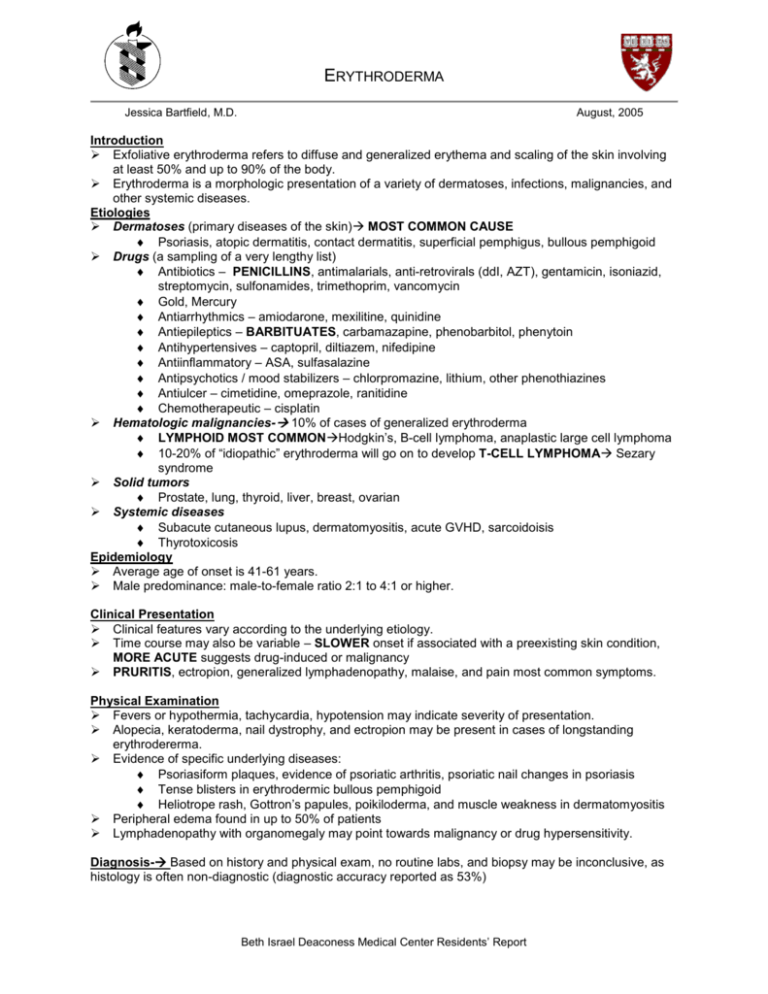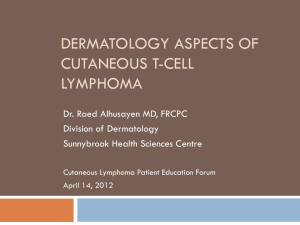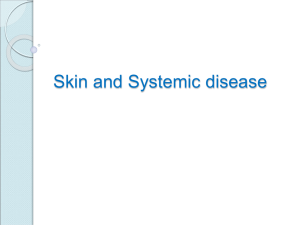Erythroderma
advertisement

ERYTHRODERMA Jessica Bartfield, M.D. August, 2005 Introduction Exfoliative erythroderma refers to diffuse and generalized erythema and scaling of the skin involving at least 50% and up to 90% of the body. Erythroderma is a morphologic presentation of a variety of dermatoses, infections, malignancies, and other systemic diseases. Etiologies Dermatoses (primary diseases of the skin) MOST COMMON CAUSE Psoriasis, atopic dermatitis, contact dermatitis, superficial pemphigus, bullous pemphigoid Drugs (a sampling of a very lengthy list) Antibiotics – PENICILLINS, antimalarials, anti-retrovirals (ddI, AZT), gentamicin, isoniazid, streptomycin, sulfonamides, trimethoprim, vancomycin Gold, Mercury Antiarrhythmics – amiodarone, mexilitine, quinidine Antiepileptics – BARBITUATES, carbamazapine, phenobarbitol, phenytoin Antihypertensives – captopril, diltiazem, nifedipine Antiinflammatory – ASA, sulfasalazine Antipsychotics / mood stabilizers – chlorpromazine, lithium, other phenothiazines Antiulcer – cimetidine, omeprazole, ranitidine Chemotherapeutic – cisplatin Hematologic malignancies- 10% of cases of generalized erythroderma LYMPHOID MOST COMMONHodgkin’s, B-cell lymphoma, anaplastic large cell lymphoma 10-20% of “idiopathic” erythroderma will go on to develop T-CELL LYMPHOMA Sezary syndrome Solid tumors Prostate, lung, thyroid, liver, breast, ovarian Systemic diseases Subacute cutaneous lupus, dermatomyositis, acute GVHD, sarcoidoisis Thyrotoxicosis Epidemiology Average age of onset is 41-61 years. Male predominance: male-to-female ratio 2:1 to 4:1 or higher. Clinical Presentation Clinical features vary according to the underlying etiology. Time course may also be variable – SLOWER onset if associated with a preexisting skin condition, MORE ACUTE suggests drug-induced or malignancy PRURITIS, ectropion, generalized lymphadenopathy, malaise, and pain most common symptoms. Physical Examination Fevers or hypothermia, tachycardia, hypotension may indicate severity of presentation. Alopecia, keratoderma, nail dystrophy, and ectropion may be present in cases of longstanding erythrodererma. Evidence of specific underlying diseases: Psoriasiform plaques, evidence of psoriatic arthritis, psoriatic nail changes in psoriasis Tense blisters in erythrodermic bullous pemphigoid Heliotrope rash, Gottron’s papules, poikiloderma, and muscle weakness in dermatomyositis Peripheral edema found in up to 50% of patients Lymphadenopathy with organomegaly may point towards malignancy or drug hypersensitivity. Diagnosis- Based on history and physical exam, no routine labs, and biopsy may be inconclusive, as histology is often non-diagnostic (diagnostic accuracy reported as 53%) Beth Israel Deaconess Medical Center Residents’ Report Complications Thermoregulatory disturbance –increased heat losses via dilated cutaneous vessels Fluid and electrolyte imbalances Hypoalbuminemia and malnutrition – daily protein loss increased by 25% in psoriatic erythroderma High output heart failure – possibly secondary to increased blood flow through cutaneous vessels Liver and renal dysfunction (more common in hypersensitivity reactions) Acute respiratory distress syndrome and capillary leak syndrome Infection – the primary cause of death in patients with erythroderma bacterial superinfections Therapy HYDRATION AND NUTRITION Warm, humidified environment Fluid and electrolyte replacement Local skin care: oatmeal baths, wet dressings to weeping or crusted sites followed by bland emollients and low-potency topical corticosteroids. High potency topical steroids are usually avoided due to concerns for systemic absorption. Avoid skin irritants. Sedating oral antihistamine advocated for treatment of pruritis and anxiety Systemic therapy dictated by underlying diagnosis Prognosis Depends on cause, but case series have documented erythroderma-related death rates from 0% to 64% Beth Israel Deaconess Medical Center Residents’ Report Beth Israel Deaconess Medical Center Residents’ Report

![Anti-Cytokeratin antibody [AE1AE3] ab174707 Product datasheet 1 Image Overview](http://s2.studylib.net/store/data/012747555_1-02dfbd38a388870acc4075884fa092c1-300x300.png)








